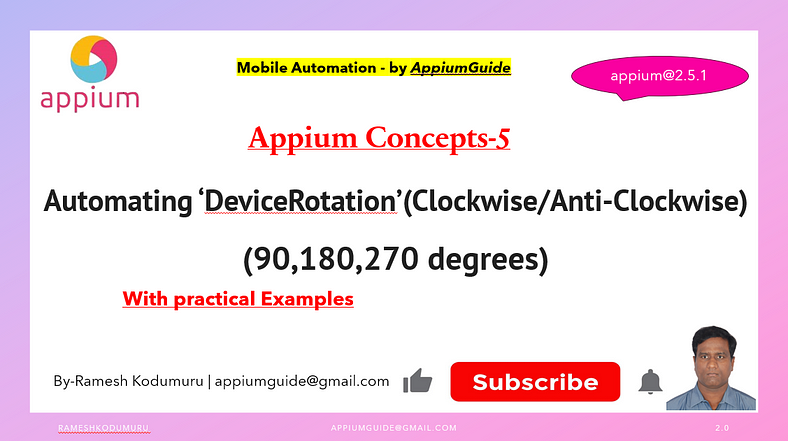Appium Concepts: Automate & Control Device Rotation: Clockwise & Anti-Clockwise Made Simple!(90°, 180°, 270°)

Please go through the below video for complete details:
Command — .rotate(new DeviceRotation(x-axis, y-axis, z-axis))
Introduction:
Automating device rotation in Appium 2 for mobile automation can be chieved using the rotate command. This allows rotating the device to 90, 180, or 270 degrees either clockwise or anti-clockwise.
Appium Java client provides a method — “.rotate(new DeviceRotation(x-axis, y-axis, z-axis))”.
By using “.rotate” method , User can able to rotate device during the test execution.
driver.rotate(new DeviceRotation(int x,int y,int z));Things To Remember:
- X,Y, Z co-ordinates will accept only — 0,90,180,270 values.
- User can’t use negative values like -90,-180
“Complete Code: Optimized and Ready to Use”:
package com.appiumguide.appiumconcepts;
import java.net.MalformedURLException;
import java.net.URL;
import java.time.Duration;
import org.openqa.selenium.DeviceRotation;
import org.testng.annotations.AfterTest;
import org.testng.annotations.BeforeTest;
import org.testng.annotations.Test;
import io.appium.java_client.android.AndroidDriver;
import io.appium.java_client.android.options.UiAutomator2Options;
/**
* Script Details - Appium Concepts : Automating ‘DeviceRotation’(Clockwise/Anti-Clockwise)(90,180,270 degrees)
*
* appium-java-client version: 9.3.0
*
* @author 'Ramesh Kodumuru' for AppiumGuide [appiumguide@gmail.com]
*/
public class DevicerotationTest {
private AndroidDriver driver;
@BeforeTest
public void steup() throws MalformedURLException {
UiAutomator2Options cap =new UiAutomator2Options();
cap.setPlatformName("android");
cap.setAutomationName("uiautomator2");
cap.setDeviceName("Pixal7a");
cap.setAppPackage("com.google.android.deskclock");
cap.setAppActivity("com.android.deskclock.DeskClock");
//cap.setOrientation(currentorientation.LANDSCAPE);
driver=new AndroidDriver(new URL("http://127.0.0.1:4723"), cap);
driver.manage().timeouts().implicitlyWait(Duration.ofSeconds(10));
}
@AfterTest
public void teardown() {
if(driver!=null) {
driver.quit();
System.out.println("Test Execution Completed");
}
}
@Test
public void rotationExample() throws InterruptedException {
//Rotating the device in clockwise direction
// i.m rotating the device 90 degree i.e right
System.out.println("Rotating the device in clockwise direction");
driver.rotate(new DeviceRotation(0, 0, 90));
System.out.println("device rotate to 90 degree i.e right side");
Thread.sleep(10000);
driver.rotate(new DeviceRotation(0, 0, 180));
System.out.println("device rotate to 180 degree i.e up down side");
Thread.sleep(10000);
driver.rotate(new DeviceRotation(0, 0, 270));
System.out.println("device rotate to 270 degree i.e left side");
Thread.sleep(10000);
driver.rotate(new DeviceRotation(0, 0, 0));
System.out.println("device rotate to 0 degree i.e normal position");
Thread.sleep(10000);
//Rotating the device in anti-clockwise direction
// i.m rotating the device 90 degree i.e right
System.out.println("Rotating the device in anti-clockwise direction");
driver.rotate(new DeviceRotation(0, 0, 270));
System.out.println("device rotate to 270 degree i.e left side");
Thread.sleep(10000);
driver.rotate(new DeviceRotation(0, 0, 180));
System.out.println("device rotate to 180 degree i.e up down side");
Thread.sleep(10000);
driver.rotate(new DeviceRotation(0, 0, 90));
System.out.println("device rotate to 90 degree i.e right side");
Thread.sleep(10000);
driver.rotate(new DeviceRotation(0, 0, 0));
System.out.println("device rotate to 0 degree i.e normal position");
Thread.sleep(10000);
}
}Explore on GitHub:

No comments:
Post a Comment